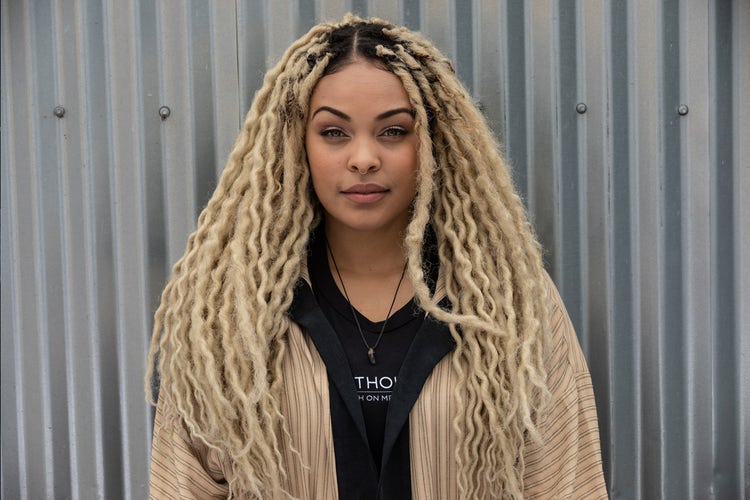Larayia Gaston: Small Steps Build Strong Bonds With LA’s Forgotten

Lunch on Me (LOM), a nonprofit that serves thousands organic meals to the homeless on Los Angeles’ skid row, provides much more than food. Founder Larayia Gaston has built a community for collective mind, body and spiritual wellness. In addition to the meals—created from redistributed organic food that would otherwise be wasted—LOM provides yoga classes, healing gatherings and “Love Without Reason” community block parties that offer free haircuts, manicures and music.
With full bellies, full hearts and a tightknit community of people who care, Gaston believes LOM provides a foundation for permanent healing to the 10,000 people a month they service in LA. And she thinks her model can be replicated all over the world. Lunch on Me New York just launched, and we can’t wait to see how her incredible work changes subway culture.
24Life spoke with Gaston about the evolution of LOM and how small acts of kindness can make a big impact. Read on for immediate inspiration.
Finding purpose

Gaston grew up in a church community that stressed tithing, giving 10 percent of what you earn back to the church for philanthropic use. She loved the idea of giving back but asked her mom if she could give her tithe as food instead of money. When her mom said, “I don’t care what you do, just do your part,” the seed for LOM was planted.
Gaston spent the next decade preparing and serving food to those in need. “I realized my tribe definitely comes from the neglected, the forgotten people of the world,” she says.
When she moved to LA, Gaston stumbled on skid row, home to roughly 10,000 homeless people. Despite what looked like a state of emergency, with tents and sleeping bags lining the sidewalks, Angelinos seemed to walk or drive through the area with little regard for the suffering. “It was normalized and it was so established … I felt like I had to do something about it,” Gaston says.
Gaston had been disappointed with the nonprofits she had volunteered with in the past. Aside from corruption, she saw a lack of connection with, and even disregard for, the people being served. “I didn’t know anything about the nonprofit world, but I knew how to love people, so I took it from there,” she explains.
Gaston thought she could do a better job addressing homelessness in LA, so she did. “It’s that simple,” she says, “someone was hungry and I fed them.”
Focusing on intention

From LOM’s inception, Gaston vowed to never serve anything she herself wouldn’t eat. She works hard to make her meals both nutritious and attractive. That latter is important to her because presentation implies intent, and intent implies care. “It’s never been about the food,” she says, but rather the energy and sacrifice that goes into creating the food.
Over time, Gaston came to realize that intent, not just in how the food looked but also how it was served, was crucial. Gaston recalls the moment that became clear. She was passing out cold-pressed juice on skid row when she came across a man, presumably under the influence of drugs, passed out on the sidewalk. Instead of stepping by him, she placed a drink at his side and said she would sit there until he took a few sips.
He drank and she continued to hand out juice. Seven months later, and miles away at an event in upscale Beverly Hills, that man and Gaston crossed paths again. He revealed that her actions were life-changing. Although he had a family who cared about him, it took a stranger’s care to inspire him to care more for himself. He checked into rehab as soon as he was sober enough to do so.
Embracing growth

As she began forming relationships with members of the homeless community and immersing herself in their experience by living in a skid row tent for 43 days, Gaston learned that most residents didn’t have a network of friends and family to rely on for emotional support. She decided that in addition to providing food, she would build a community of caring individuals.
“We bring the family aspect. We take people out for their birthdays,” Gaston says. LOM also makes sure residents look and feel good by offering grooming services, healing gatherings and yoga classes.
Yoga and meditation have been particularly impactful in Gaston’s own life. She believes bringing the disciplines to skid row gives the homeless population a tool to process the daily trauma of life on the streets. Eventually, she’d like to open brick-and-mortar wellness studios where skid row residents and foster youth would act as the teachers.
Advocating kindness
People often ask Gaston how they too can help with the homeless crisis. Aside from volunteering with LOM, she always tells people to start small to avoid getting overwhelmed. “We look at 58,000 homeless people in LA, and we’re so fixated on that number that we walk past the person in front of our grocery store,” she explains. Instead of focusing on how you can change the world, she suggests narrowing your focus to your own, smaller community. Look for familiar faces at the places you frequent: Ask the man by the local market if he’d like a few of the apples you bought; see if the woman by the coffee shop needs a warm drink.
Gaston believes that these kind micro-gestures, not once-a-year holiday giving, are what truly elicit change and build community. She says the best first step is to stock your car, purse or backpack with granola bars so that you can offer them up when you see someone in need. “You might not always have cash to give,” Gaston says, “but never let someone leave empty-handed.” Gaston also keeps five-dollar bills handy, since they are relatively modest but allow for a significant food or toiletry purchase.
The most incredible thing about everyday micro-gestures, according to Gaston, is that you are filling so much more than a person’s basic needs. By stopping and asking if they need help, you are seeing them as human and recognizing their suffering. You are showing them that someone cares. As evidenced by Gaston’s juice story, the care of a single stranger can have monumental, lasting effects.
While seeing and helping those in need may require some mindfulness at first, Gaston says the pursuit quickly becomes automatic. “What we practice becomes a habit, and practiced habits become innate,” she says. Kindness will simply be part of your every day to the vast benefit of not just your community but also yourself. In addition to feeling empowered, you’ll feel connected. And, she adds, connection is the cornerstone to making a big world with big problems more manageable.

Video and photo credit: Tom Casey, box24studio.com
Hair and makeup: Chanel